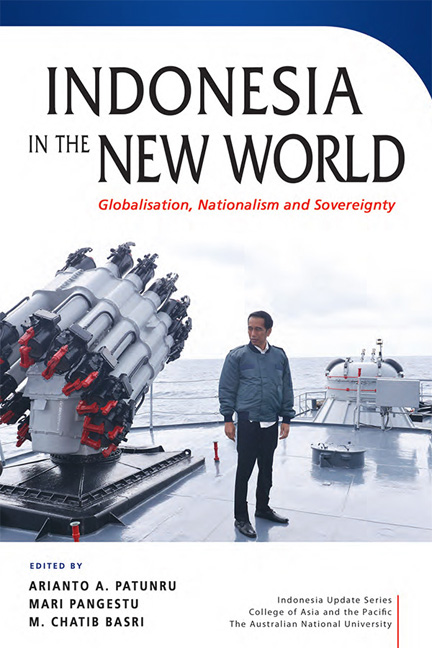Book contents
- Frontmatter
- Contents
- Tables
- Figures
- Contributor
- Acknowledgments
- Glossary
- 1 Challenges for Indonesia in the new world
- PART 1 Globalisation, Nationalism and Sovereignty: the Indonesian Experience
- 2 Challenging geography: asserting economic sovereignty in a porous archipelago
- 3 The new nationalism in Indonesia
- 4 Nationalism, sovereignty and foreign policy: Indonesia and the disputes over the South China Sea
- PART 2 Nationalism in Practice
- PART 3 Impact of and Response to Globalisation
- PART 4 The Human Face of Globalisation
- PART 5 Navigating The New Globalisation
- Index
- INDONESIA UPDATE SERIES
2 - Challenging geography: asserting economic sovereignty in a porous archipelago
from PART 1 - Globalisation, Nationalism and Sovereignty: the Indonesian Experience
Published online by Cambridge University Press: 08 June 2019
- Frontmatter
- Contents
- Tables
- Figures
- Contributor
- Acknowledgments
- Glossary
- 1 Challenges for Indonesia in the new world
- PART 1 Globalisation, Nationalism and Sovereignty: the Indonesian Experience
- 2 Challenging geography: asserting economic sovereignty in a porous archipelago
- 3 The new nationalism in Indonesia
- 4 Nationalism, sovereignty and foreign policy: Indonesia and the disputes over the South China Sea
- PART 2 Nationalism in Practice
- PART 3 Impact of and Response to Globalisation
- PART 4 The Human Face of Globalisation
- PART 5 Navigating The New Globalisation
- Index
- INDONESIA UPDATE SERIES
Summary
The world's largest archipelago, lying athwart one of the world's major trade arteries, is an unlikely location for a single mercantilist or protec¬tionist nation-state. The much smaller Caribbean provides the closest comparison to Indonesia in terms of tropical archipelagos that are highly accessible to world trade, but it is divided among 14 sovereignties, heirs to the world's contesting powers. Even other centres of world trade without an archipelagic character, such as the Middle East and the Low Countries of Europe, have been marked by a plurality of commercial city-states or autonomous cities, morphing into a variety of competing modern states.
Throughout recorded history, the strategic location of the Malacca and Sunda Straits, and the alternation of monsoon winds carrying sailing ships between the Indian and Pacific Oceans, made the archipelago and pen-insula—Nusantara—a natural centre for mercantile city-states living by trade (Reid 2000). Its spices were the chief prize of the global maritime struggles of the fifteenth to seventeenth centuries, motivating explorers such as Christopher Columbus and Vasco da Gama to discover new sea routes to this part of the world. Despite the modern nationalist imaginings of the ancestral ‘empires’ of Sriwijaya and Majapahit, the fundamental reality of the region before 1650 was of multiple port-states competing to attract the world's traders. Yet somehow the idea of a state monopoly of trade developed very deep roots in this region, despite having to contend with a very different reality.
This idea seems to have taken deepest root in Imperial China. The curious fiction that China needed no external trade meant that for lengthy periods before 1567 the only form of international exchange the Chinese court would accept as legal was that associated with the so-called tribute missions from a few ‘barbarian’ kingdoms that were able to play this game. Those that did play it successfully—from Sriwijaya in the seventh to eleventh centuries to Pasai (northern Sumatra) and Melaka in the fif¬teenth—gained a kind of theoretical monopoly over the lucrative trade with China. Indeed, Chinese court records make it appear as though the only legitimate traders were those from the tribute-sending polities.
- Type
- Chapter
- Information
- Indonesia in the New WorldGlobalisation, Nationalism and Sovereignty, pp. 17 - 34Publisher: ISEAS–Yusof Ishak InstitutePrint publication year: 2018

